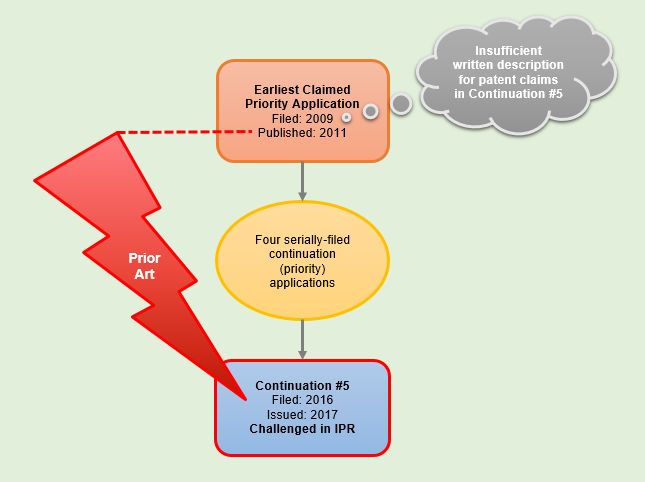- with Senior Company Executives, HR and Finance and Tax Executives
- with readers working within the Healthcare, Technology and Metals & Mining industries
In Indivior UK Ltd. v. Dr. Reddy's Laboratories S.A., Appeals 2020-2073, -2142 (Fed. Cir. Nov. 24, 2021), the Federal Circuit affirmed a Patent Trial and Appeal Board's final decision canceling claims in Indivior's patent claiming a polymer matrix-containing film. Certain claims in the patent recited an amount of polymer matrix inadequately disclosed, according to the Board, in a predecessor application to which the patent claimed priority. As a result, the claims' effective filing date was so late that prior art published between the patent's actual filing date and its earliest claimed priority date rendered the claims unpatentable. Here the prior art was none other than the Patent Office's publication of one of the claimed priority applications. Thus, a specification insufficient to describe these claims was sufficient to anticipate them. This case provides a good example of how-during inter partes review-to indirectly challenge a patent's written description and apply an earlier publication of that description to attack the patent's claims.
Indivior's patent issued in 2017 from the fifth continuation in a series of applications (including four abandoned applications) dating back to a first continuation filed in 2013, and to an earlier application filed in 2009, which published in 2011. The patent claims recited embodiments of a film that includes "about 40 wt % to about 60 wt % of a water-soluble polymeric matrix" (claim 1), "about 48.2 wt % to about 58.6 wt %" of the matrix (dependent claims 7 and 12), and "about 48.2 wt %" of the matrix (dependent claim 8). The Board and court had to decide whether "Indivior can get the benefit of that 2009 filing date for the claims at issue." Indivior, Slip Op. at 2. The Board found that the 2009 application did not disclose the recited ranges, that Indivior's expert's testimony to the contrary was not credible, and that the skilled person would have been led away from the recited ranges because the 2009 application stated that the "film may contain any desired level of self-supporting film forming polymer." Id. at 5 (emphasis added). The limited specification support (e.g., exemplary film compositions) was sufficient, however, to anticipate the claims reciting ranges. See Titanium Metals Corp. of Am. v. Banner, 778 F.2d 775, 782 (Fed. Cir. 1985) (stating the "elementary principle of patent law that when, as by a recitation patent claims. of ranges or otherwise, a claim covers several compositions, the claim is 'anticipated' if one of them is in the prior art" (citation omitted)). The Board therefore concluded that the 2011 publication of Indivior's earliest claimed priority application anticipated those patent claims.

On appeal, the court reiterated that the test for adequate written description in a claimed priority application is whether the disclosure therein "conveys to those skilled in the art that the inventor had possession of the claimed subject matter" as of that application's filing date. Indivior, Slip Op. at 9 (citation omitted). Continuing, the court explained that "the specification [of the claimed priority application] must indicate with some clarity what the claim recites," and, "[i]n the case of a claimed range, a skilled artisan must be able to reasonably discern a disclosure of that range." Id. The court applied that test and rejected Indivior's argument that the recited ranges are supported by compositional data tables in the priority application disclosing film compositions having 48.2 wt % and 58.6 wt % polymer, and disclosure in the application stating the composition includes at least about 25 wt % polymer or at least about 50 wt % polymer. Id. at 9-11.
The court's opinion referenced a 1976 Court of Customs and Patent Appeals decision that explained compliance with the written description requirement "ensure[s] that the inventor had possession, as of the filing date of the application relied on, of the specific subject matter later claimed by him." In re Wertheim, 541 F.2d 257, 262 (CCPA 1976) (Rich, J.). Wertheim's rejected patent application claims recited a range (solids content of "between 35% and 60%"), id. at 264, whereas the specification disclosed a broader range ("concentrated . until a concentration of 25 to 60% solid matter is reached"), id. at 262 (internal quotation marks omitted), along with specific embodiments (solids content of 36% and 50%), id. at 265. In concluding that Wertheim's specification supported the claimed range, even though the precise range was not repeated verbatim in the specification, the CCPA opined that "persons skilled in the art would consider processes employing a 35-60% solids content range to be part of [Wertheim's] invention and would be led by the [specification's] disclosure so to conclude." Id.
Consistent with Wertheim, the Federal Circuit said that even though the recited ranges need not be disclosed, Indivior's priority application disclosed nothing suggesting the claimed ranges were "contemplated as an aspect of the invention." Indivior, Slip Op. at 9. Disclosure of unbound ranges (e.g., at least 25%, at least 50%), in contrast to the bounded range in Wertheim, was not enough to satisfy the written description requirement. Example compositions having multiple polymers in amounts that, once aggregated, fall within or happen to be end points of the newly-recited ranges also were not enough:
Here, one must select several components, add up the individual values, determine the aggregate percentages, and then couple those aggregate percentages with other examples in the [priority] application to create an otherwise unstated range. That is not a written description of the claimed range.
Id. at 10. Substantial evidence, according to the court, therefore supported the Board's conclusion that Indivior's priority application did not adequately describe the patent claims reciting ranges, although it did adequately describe the claim not reciting a range (claim 8). The court therefore affirmed the Board's decision. Id. at 11-12.
Judge Rich long ago noted that, in written description cases, "[t]he primary consideration is factual and depends on the nature of the invention and the amount of knowledge imparted to those skilled in the art by the disclosure." Wertheim, 541 F.2d at 262. The dissent identified record facts that might support a conclusion contrary to the one the Board and the court's majority reached. But given the deferential standard of appellate review, the dissent's remarks seem academic. See, e.g., In re NTP, Inc., 654 F3d 1279, 1292 (Fed. Cir. 2011) (noting the "Court does not reweigh evidence on appeal, but rather determines whether substantial evidence supports the Board's fact findings"). Here, prolonged, and perhaps tortuous, prosecution-including four earlier abandoned continuation applications-led to the Patent Office eventually issuing Indivior a patent with claims reciting ranges invented years after the relevant priority applications were filed and published. Ultimately, what Indivior unsuccessfully argued supported the claimed ranges, anticipated those ranges.
The content of this article is intended to provide a general guide to the subject matter. Specialist advice should be sought about your specific circumstances.


